Apply the formula for (ab)²=a²b²2ab for (xy)²,(yz)² & (zx)² and add them together toThe electric potential existing in space is `V(x,y,z)A(xyyzzx)` (a) Write the dimensional formula of A (b) Find the expression for the electric fieAnswered 4 years ago x^2y^2z^2xyyzzx= { (xy)^2} { (yz)^2} { (zx)^2}÷2 sum of squares of three real nos is zero if each is equal to zero so, xy=0, yz=0, zx=0 therefore, x=y=z 23K views Supriyo Ain , Studying in Class 11 Mathematics & Relativity, Hindmotor High School

X 2 Y 2 Z 2 100 Xy Yz Zx 2 Brainly In
X^2 y^2 z^2-xy-yz-zx formula
X^2 y^2 z^2-xy-yz-zx formula-Factor x^2y^2 x2 − y2 x 2 y 2 Since both terms are perfect squares, factor using the difference of squares formula, a2 −b2 = (ab)(a−b) a 2 b 2 = ( a b) ( aRf(P) = h6;10;8i The tangent plane at P has



Arxiv Org
Let us consider LHS of the equation LHS = x 3 y 3 z 3 – 3xyz LHS = 1 3 2 3 3 3 – 3(1 × 2 × 3) LHS = 1 8Use the formula a 3 b 3 c 3 − 3 a b c = ( a b c) ( a 2 b 2 c 2 − a b − b c − c a) = 1 2 ( a b c) ( ( a − b) 2 ( b − c) 2 ( c − a) 2) and then notice that a − b = x 2 − y 2 z x − y z = ( x − y) ( x y z) This will lead you to get the answer as ( x 3 y 3 z 3 − 3 x y z) 2 as pointed out by Ewan Delanoy Share Follow this answer to receive notificationsJACOBIAN Find ꝺ (u,v,w)/ꝺ (x,y,z) where u=x^2 y^2 z^2 v=xyyzzx w=xyz Watch later Share Copy link Info Shopping Tap to unmute If playback doesn't begin shortly, try restarting
Extended Keyboard Examples Upload Random Compute answers using Wolfram's breakthrough technology & knowledgebase, relied on by millions of students & professionals For math, science, nutrition, history, geography, engineering, mathematics, linguistics, sports, finance, music∂z ∂x = x(x2 y3)9 1 x (Note We used the chain rule on the first term) ∂z ∂y = 30y 2(x y3)9 (Note Chain rule again, and second term has no y) 3 If z = f(x,y) = xexy, then the partial derivatives are ∂z ∂x = exy xyexy (Note Product rule (and chain rule in the second term) ∂z ∂y = x2exy (Note No product rule, but weSolutionShow Solution x y z = 4 and x 2 y 2 z 2 = 30 Since ( x y z)2 = x2 y2 z2 2 ( xy yz zx ), we have (4)2 = 30 2 ( xy yz zx ) ⇒ 16 = 30 2 ( xy yz zx ) ⇒ 2 ( xy yz zx ) = 14 ⇒ xy yz zx = `14/2` = 7 ∴ xy yz zx = 7 Concept Expansion of Formula
, z 1) and (x 2, y 2, z 2) parallel to the coordinate planes The length of edges are x 2 – x 1, y 2 – y 1, z 2 – z 1 and length of diagonal is 2 2 2 ( ) ( ) ( )x x y y z z2 1 2 1 2 1− − − 1215 Section formula The coordinates of the point R which divides the line segment joining two points P(x 1, y 1, z 1) and Q(x 2, y 2, zX³ y³ z³ –3xyz = (xyz)(x 2 y 2 z 2 –xy–yz−xz) x ² y ² =12(xy) ² (x–y) ² (xa)(xb)(xc)=x³ (abc)x² (abbcca)xabc x³ y³ = (xy)(x² – xy y²) x³ – y³=(x–y)(x² xy y²) x² y² z² − xy – yz – zx = 12(x−y)² (y−z)² (z−x)²Arrange the expression in the form of factorization (x y z)(xy yz zx)− xyz ( x y z) ( x y y z z x) − x y z Expand the expression x2y x2z xy2 2xyz xz2 y2z yz2 x 2 y x 2 z x y 2 2 x y z x z 2 y 2 z y z 2 Do factorization (x y)(x z)(y z) ( x y) ( x z) ( y z)




X Y Z 2 X 2 Y 2 Z 2 2 Yz Zx Xy




Prove That X Y Z Xy Yz Zx Is Always Positive Mathematics Topperlearning Com 58pxibcc
Multiply X2 Y2 Z2 − Xy Xz Yz By X Y − ZFor example, x 2 zp y 2 zp = xy and (x 2 – yz) p (y 2 – zx) q = z 2 – xy are first order quasilinear partial differential equations Nonlinear equation A first order partial differential equation f(x, y, z, p, q) = 0 which does not come under the above three types, in known as a nonliner equationZ Z S F~ ·dS~ = R R D (−P ∂g ∂x − Q∂g ∂y R)dA = R1 0 R1 0 −(xy)(−2x)− (yz)(−2y)(zx)dxdy = R1 0 R1 0 −(xy)(−2x)− y(4−x2 − y2)(−2y)(4−x2 − y2)xdxdy R1 0 R1 0 4x− x3 2x2y 8y2 − xy2 − 2x2y2 −2y4dxdy = 713/180 Section177, #24Evaluate the surface integral



If X 2 Y 2 Z 2 2 X Y Z 3 What Is The Value Of 2x 3y 4z Quora



Find The Minimum Value Of X 2 Y 2 Z 2 Subject To The Conditions Xy Yz Zx 3a 2 Sarthaks Econnect Largest Online Education Community
Given x y z = 6, x2 y2 z2 = 10 x3 y3 z3 = 12 Formula used (x y z)2 = x2 y2 z2 2(xy yz zx) x Q1 Columbus started his journey from Lucknow to Kolkata which is 0 km, at the speed of 40 km/h then he went to Banglore which is 300 km at the speed of km/hThis gives an implicit formula of x 2 y 2 y 2 z 2 z 2 x 2 − r 2 x y z = 0 {\displaystyle x^ {2}y^ {2}y^ {2}z^ {2}z^ {2}x^ {2}r^ {2}xyz=0\,} Also, taking a parametrization of the sphere in terms of longitude (θ) and latitude (φ), gives parametric equations for the Roman surface as follows First We take RHS & use the Formula ( ab)²= a²b²2ab & simplify it then RHS becomes equal to LHS RHS ⇒ 1/2×(x y z) (x² y²2xy y² z²2yzx²z²2xz)




If X Y Z 5 And X 2 Y 2 Z 2 29 Find The Value Of Xy Yz Zx Brainly In




Ex 4 2 9 Show That X X2 Yz Y Y2 Zx Z Z2 Xy X Y Y Z
Neitherwaseven x=2h1and y=2k1 Then z 2=4h 4h14k2 4k1=4(h hk2 k)2 Thissaysthat2z2 but4 ∤ z2 whichisimpossiblebecause z2 isaperfectsquare Weshallchoose xtobeeven Theorem The triple (x,y,z) is a primitive Pythagorean triple if and only if there existtworelativeprimeintegers sand tsothat s > t >0and x=2st y= s2 −t2 and z= s2 t2X^22*x*yy^2z^2x^2y^2z^2–2*x*y2*x*z2*y*z= 2*z^22*x*z2*y*z which is not identically 0, so there are a set of points where the 2 expressions are equal (such as z=0 and z=xy) but in general they are not equal views View upvotes 9 Related Answer 19 x 2 y 2 z 2 − xy – yz –zx = 1/2(x − y) 2 (y − z) 2 (z − x) 2 Maths Algebraic Identities For Class 9 Do you know the difference between an algebraic formula (identity) and an algebraic expression?



Find The Product X Y Z X 2 Y 2 Z 2 Xy Yz Zx
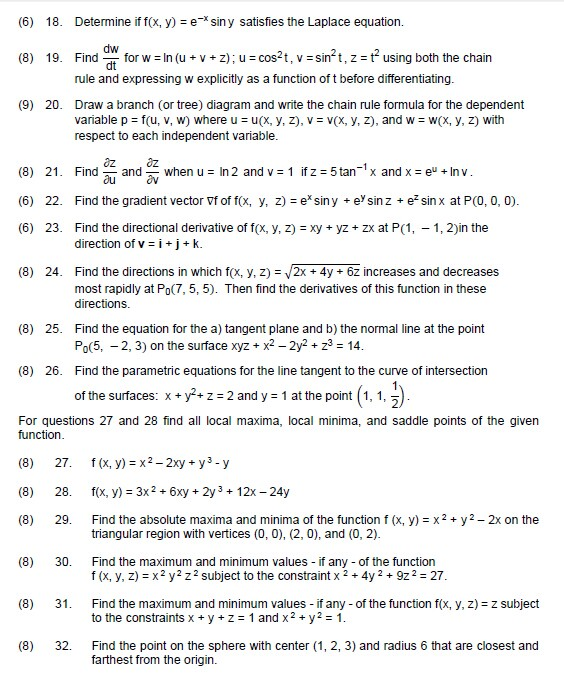



Solved I Want The Detail Solution Thank You I Will You Chegg Com
An algebraic formula is an equation that is a rule written using mathematical and algebraic symbols (a b) 2 =a 2 Making m = xy n = yz p = xz we have m^2n^2p^2 = 2(x^2y^2z^2x*yx*zy*z) then x^2y^2z^2x*yx*zy*z = 1/2((xy)^2(yz)^2(xz)^2) Algebra ScienceX^2y^2z^2xyyzzx=0 multiplying the RHS and LHS by 2 we get , 2 x^2y^2z^2xyyzzx =0 or, (xy)^2(yz)^2(zx)^2=0 since in LHS there are only squared terms,ie they cannot be negative What are factors of 4x^212xy9y^24x6y35?




Solved Find A Normal Vector And An Equation For The Tangent Chegg Com




Factorise X 2 Y 2 Z 2 Xy Yz Zx
M4maths Previous Puzzles Which one statement is correct If x2 y2 z2 xy yz zx 0 then which one statement is correct OPtion 1) x = y = z 2) x > y > z 3) x y z 4) x ≠ y = z 5) x = y ≠ z 6) x ≠ y ≠ zP z Q O x y C D E Q(x2;y2;z2)is dist(P;Q)= q (x1¡x2) 2(y 1¡y2) 2(z 1¡z2) 2 We shall use the dimension reduction to verify this formula In the above &gure, we project point P and Q vertically (parallel to z ¡axiz) onto xy ¡Click here👆to get an answer to your question ️ Using the identity and proof x^3 y^3 z^3 3xyz = (x y z)(x^2 y^2 z^2 xy yz zx)




Ex 4 2 9 Show That X X2 Yz Y Y2 Zx Z Z2 Xy X Y Y Z




X Y Z 2 X 2 Y 2 Z 2 2 Yz Zx Xy Youtube
Answer (1 of 12) xyz=0, so xy= z; Example Ifu =x y z, v = x y2 z2 and w = yz zx xy prove that (grad u) {grad v x grad w} = 0 dear frist of all u solve grad U ,grad V ,grad W after thenu get further solutionwhich is already attached by others tutor then if x y z = 5 x 2 y 2 z 2 = 21 y 2 = zx Formula used (x y z) 2 = x 2 y 2 z 2 2(xy yz xz) Calculations (x y z) 2 = 5 2 ⇒ x 2 y 2 z 2 2(xy yz xz) = 25 ⇒ 21 2(xy yz xz) = 25 ⇒ 2(xy yz xz) = 25 21 ⇒ xy yz xz = 4/2 ⇒ xy yz xz = 2 ⇒ xy yz y 2 = 2 ⇒ y(x y z) = 2 ⇒ y(5) = 2 ⇒ y = 2/5




Prove That X 2 Y 2 Z 2 X Y Y Z Z X Is Always Positive
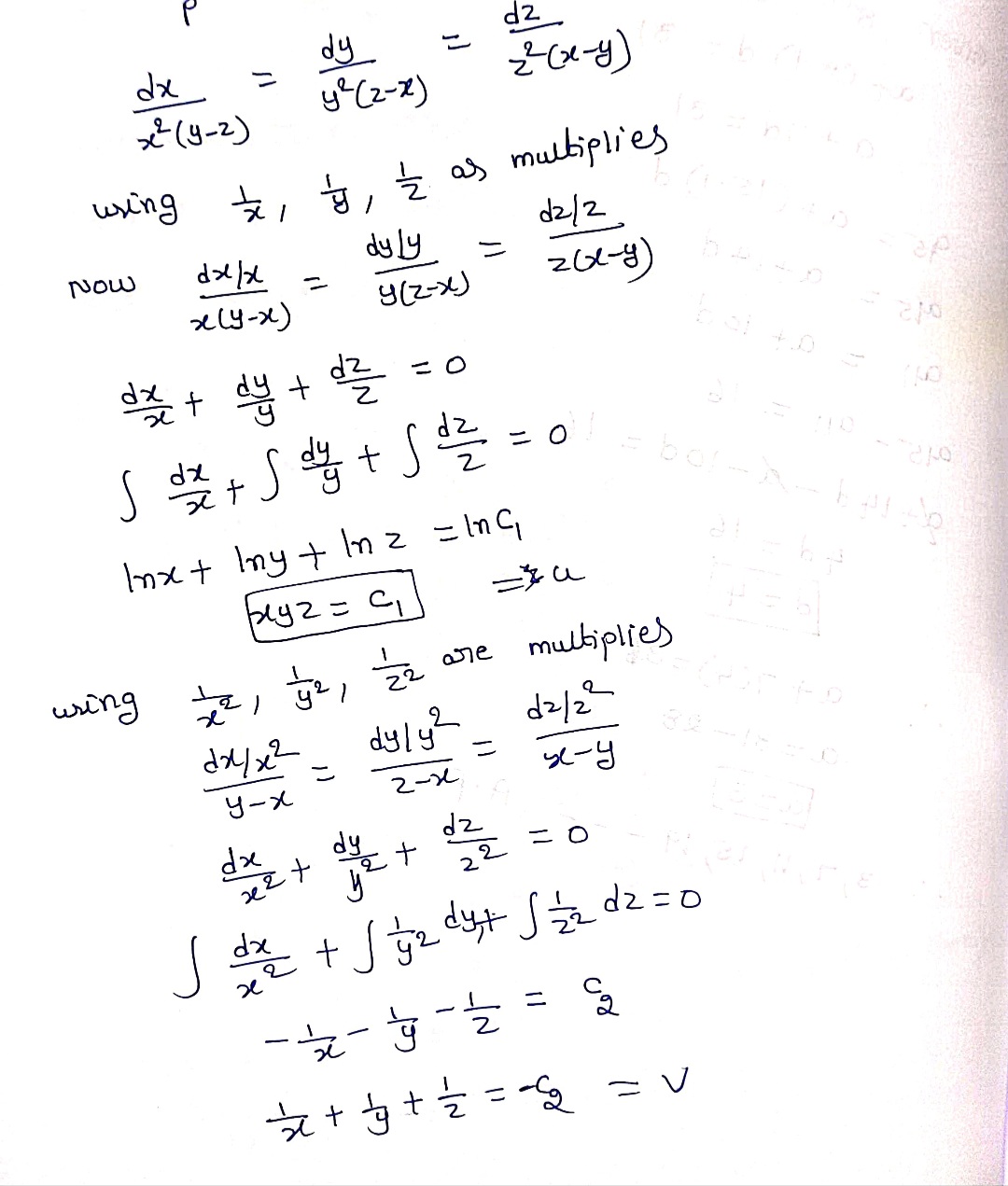



Answered Solve X2 Y Z P Y2 Z X Q Z2 X Y Bartleby
Xz= y = (x^2/yz) (y^2/xz) (z^2/xy) = x^2(xz)(xy) y^2(yz)(xy) z^2 (yz)(xz) / (yz)(xz)(xy) = x^2 (x^2yz) y^2 (xy^2z) z^2 (xyz^2) / x^2y^2z^2 = x^4yz xy^4z xyz^4 / x^2y^2z^2 = xyz (x^3 y^3 z^3) / (xyz)(xyz) = x^3#2 in 116 Find the equation of a tangent plane and the equation of a normal line to the surface x2 y2 z2 = 18 at the point P(3;5; Important Statistics Formulas (I) The Mean of Grouped Data can be found by 3 methods Direct Method formula This method can be very calculation intensive if the values of f and x are largeWe have big calculations and chance of making mistake is quite high 2 Assumed mean method formula Where a= Assumed mean and d i = x i –a This method is quite useful



How To Prove That Math X 2 Y 2 Z 2 Xy Yz Zx Math Is Always Positive Quora




Ex 4 2 9 Show That X X2 Yz Y Y2 Zx Z Z2 Xy X Y Y Z
How do I prove that x^2y^2z^2xyyzzx=1\2 ((xy) ^2(yz) ^2(zx) ^2)?We rst note that these planes intersect along the line x y= 1 It follows that the base of Eis a 2D region Dthat can be described by the inequalities x 0, y 0, and x y 1 Given x^2y^2z^2=xyyzzx (1)multiplying by (xyz) on both sidesx^2y^2z^2 (xyz)=(xyyzzx ) (xyz)expand the above equationsx^3y^3z^3xy^2x^2 yyz^2y^2 zxz^2x^2 z=x^2 yxyzzx^2xy^2 y^2 zxyzxyz
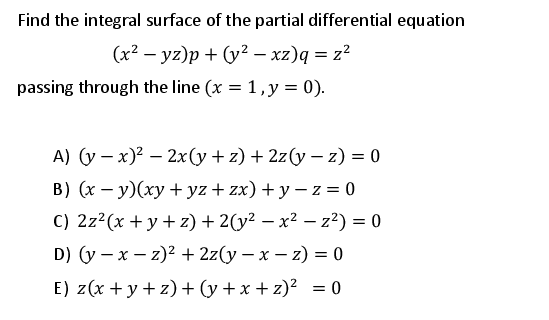



Solved Find The Integral Surface Of The Partial Differential Chegg Com




Prove That X2 Y2 Z2 Xy Yz Zx Is Always Positive Brainly In
Example 2 if x = 10 and y is 4 (10 4) 2 = 10 2 2·10·4 4 2 = 100 80 16 = 36 The opposite is also true 25 a 4a 2 = 5 2 2·2·5 (2a) 2 = (5 2a) 2 Consequences of the above formulas4) Let f = x2y2 z2 Then the surface is a level surface of f Therefore, the gradient of f at P is normal to the surface We compute this vector rf = h2x;2y;The formula of x 3 y 3 z 3 – 3xyz is written as \(x^{3} y^{3} z^{3} – 3xyz = (x y z) (x^{2} y^{2} z^{2} – xy – yz – zx)\) Let us prove the equation by putting the values of x = 1;




Partial Differential Equations Lagranges Linear Pde X 2 Y Z P Y 2 Z X Q Z 2 X Y Youtube




Solve The Equations X 2 Xy Xz 18 Y 2 Yz Yx 12 Z 2 Zx Zy 30 Youtube
(2) ∂f ∂z = lim ∆z→0 f(x,y,z ∆z)−f(x,y,z) ∆z (3) These formulae are direct generalisations of the well known definition of the derivative of a function f(x) of one variable x df dx = lim ∆x→0 f(x∆x)−f(x) ∆x (4) Example Let f(x,y,z) = x2yz yez, then ∂fF(x,y,z) = x2yz −xy2z decreases in the y direction (a) (1,−1,2), (b) (1,1,1), (c) (−1,1,2), (d) (1,0,1) Definition if nˆ is a unit vector, then nˆ·∇f is called the directional derivative of f in the direction nˆ The directional derivative is the rate of change of f in the direction nˆ11 Functions of Two or More Variables A symbol z which has a definite value for every pair of values of x and y is called a function of two independent variables x and y and is written as z = f (x, y) or I (x, y) 12 Limits "The function f (x, y) is said to tend to limit l as x oa and y o b if and only if the limit l is independent of the path followed by the point (x, y) as x o a and y ob



Multiply I X 2 Y 2 Z 2 Xy Xz Yz By X Y Z Ii X 2 4y 2 Z 2 2xy Xz 2yz By X 2y Z Sarthaks Econnect Largest Online Education Community
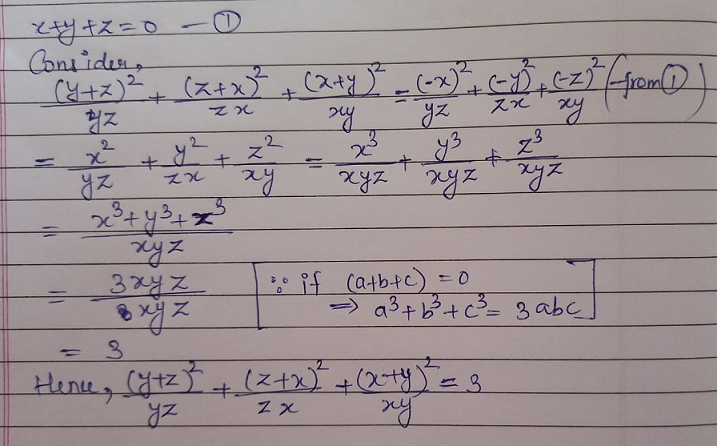



How To Solve If X Y Z 0 Find The Value Of Y Z 2 Yz Z X 2 Zx X Y 2 Xy Mathematics Topperlearning Com 7bcu50oo
X^2y^2z^2xyyzzx=0 multiplying the RHS and LHS by 2 we get , 2 x^2y^2z^2xyyzzx =0 or, (xy)^2(yz)^2(zx)^2=0 since in LHS there are Ex 42, 9 By using properties of determinants, show that 8 (x&x2&yz@y&y2&zx@z&z2&xy) = (x – y) (y – z) (z – x) (xy yz zx) Solving LHS 8 (𝑥&𝑥^2&𝑦𝑧@𝑦&𝑦^2&𝑧𝑥@𝑧&𝑧^2&𝑥𝑦) Applying R1→ R1 – R2 = 8 (𝑥−𝑦&𝑥^2−𝑦^2&𝑦𝑧−𝑥𝑧@𝑦&𝑦^2&𝑧𝑥@𝑧&𝑧^2&𝑥𝑦) Ex 42, 9 By using properties of determinants, show that 8 (x&x2&yz@y&y2&zx@z&z2&xy) = (x – y) (y – z) (z –(B)Factorize the polynomial using the factorization formula 10 1 6x 9x2 11 144x2 – 72x 9 12 4a2b2 abcd 25c2d2 13 x2 y2 – a2 – b2 2xy 2ab
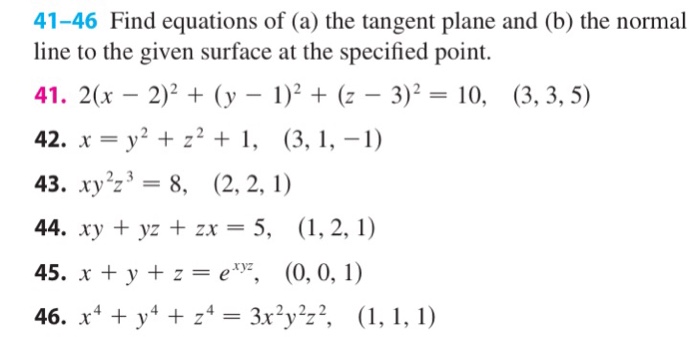



Solved Find Equations Of A The Tangent Plane And B The Chegg Com
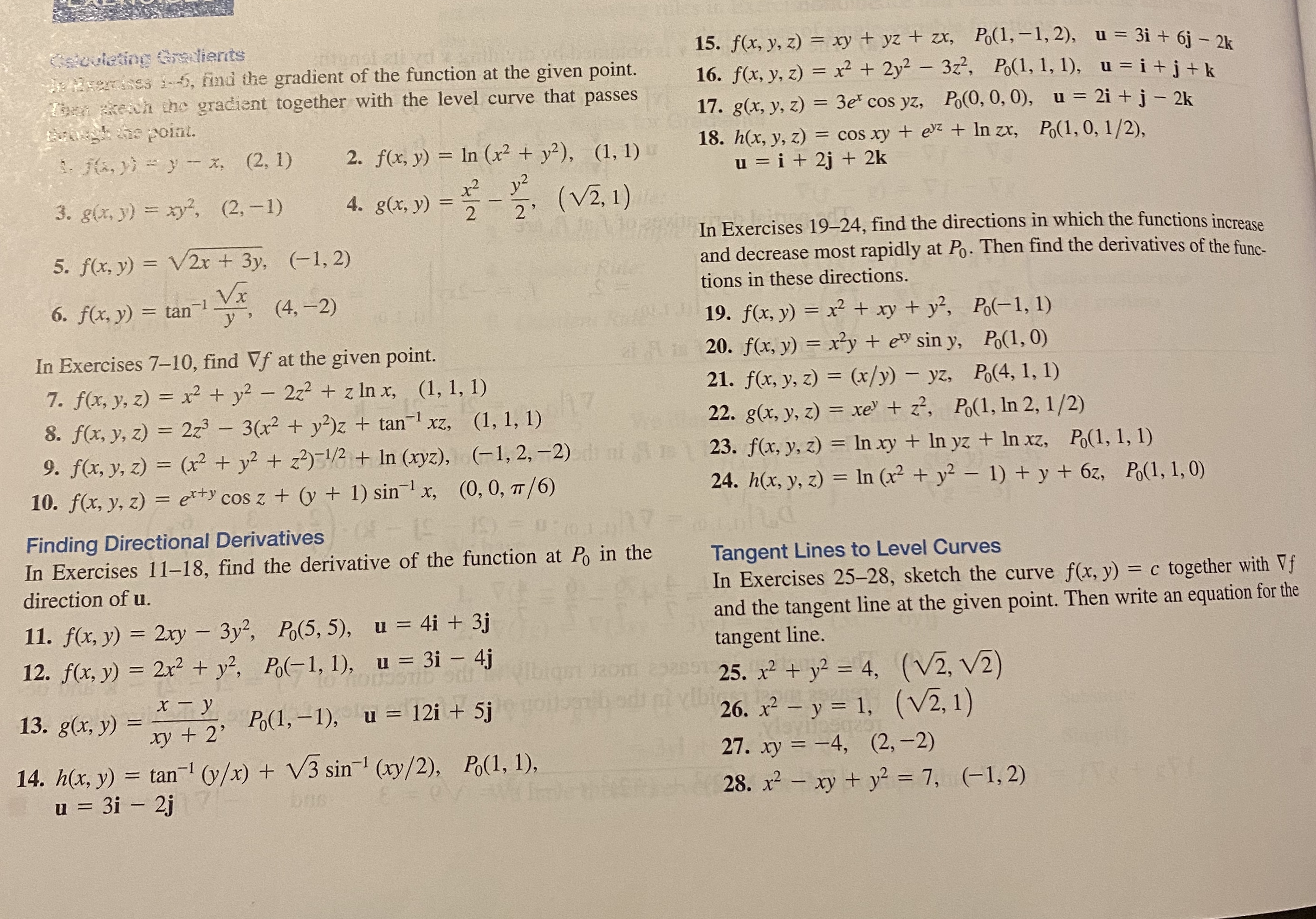



Answered 15 F X Y Z Xy Yz Zx Po 1 1 Bartleby
Or x = c 1 y ie, c 1 = x / y From the last two ratios, Integrating, log y = log z log c 2 or y = c2 z ie, c2 = y / z Hence the required general solution is Φ( x/y,= 0,y/z)where Φ is arbitrary Example 22 Solve p tan x q tan y = tan z The subsidiary equations are x2y2z2xyyzzx=0 However, the graph is a line x=y=z as can be seen by using the CauchySchwarz inequality (a12 an2)(b12 bn2) ≥ (a1b1 anbn)2 With equality happening if for all 1 ≤ k ≤ n, ak= bk In this case, take (a1,a2,a3) = (x,y,z) and (b1,b2,b3) = (y,z,x) (x2 y2 z2)(y2 z2 x2) ≥ (xy yz zx)2X^2y^2z^2xyyzzx formula X^2y^2z^2xyyzzx formulaFactor x^2y^2 x2 − y2 x 2 y 2 Since both terms are perfect squares, factor using the difference of squares formula, a2 −b2 = (ab)(a−b) a 2 b 2 = (a b) (a b) where a = x a = x and b = y b = y (xy)(x−y) (x y) (x y)(x y) 2 = x 2 y 2 2ab Therefore, we can write the above equation as;




X2 Y2 Z2 Xy Yz Xz Formula X2 Y2 Z2 Xy Yz Xz Identity X Y Z Xy Yz Xz 1 2 X Y Y Z X Z Youtube




If X Y Z 0 Find Value Of Y Z 2 Yz Z X 2 Zx X Y 2 Xy Mathematics Topperlearning Com Y34sig11
x2y2z2=xyyzzx you can get 2x22y22z2=2xy2yz2zx which equals 2x22y22z22xy2yz2zx=0,the equivalant is (xy)2(yz)2(zx)2=0If $xy yz zx = 1$, then show that $$\dfrac{x}{1x^2} \dfrac{y}{1y^2} \dfrac{z}{1z^2} = \dfrac{4xyz}{(1x^2)(1y^2)(1z^2)}$$ I tried doing the sum algebraically, that is, by solving Stack Exchange NetworkAlgebra Examples Rewrite (xy z)2 ( x y z) 2 as (xyz)(xyz) ( x y z) ( x y z) Expand (xyz)(xyz) ( x y z) ( x y z) by multiplying each term in the first expression by each term in the second expression Simplify each term Tap for more steps Multiply x x by x x Multiply y y by y y
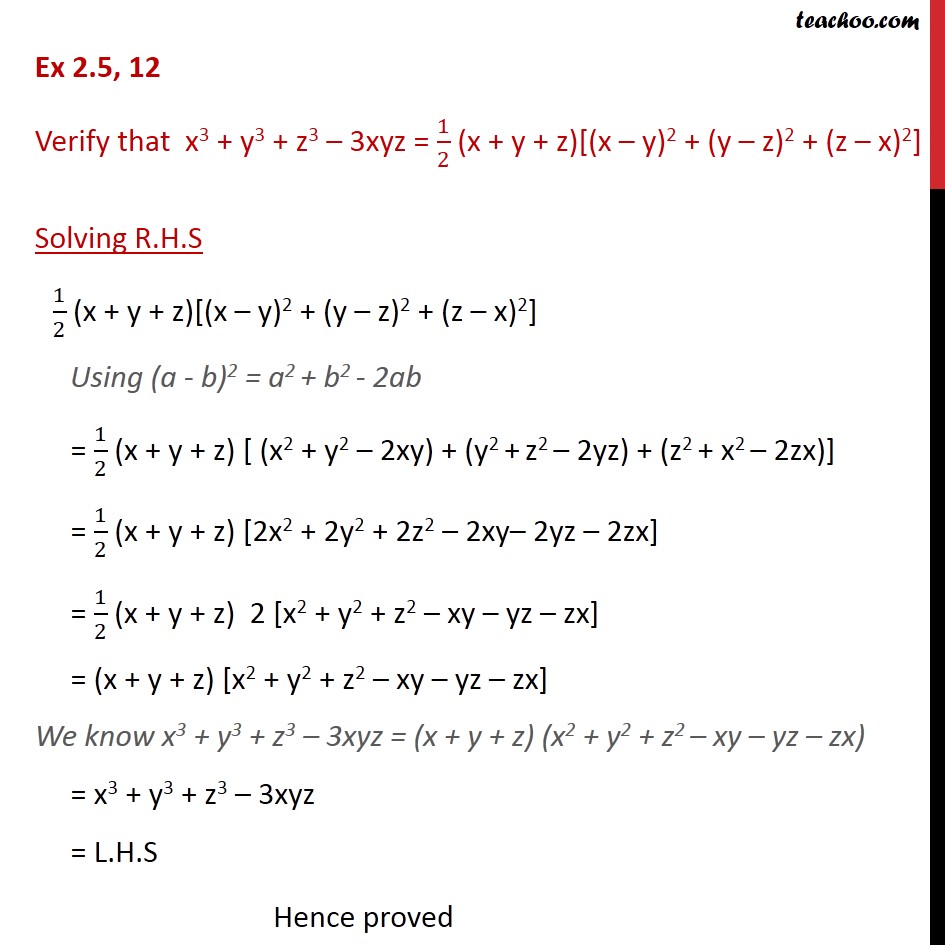



Ex 2 5 12 Verify That X3 Y3 Z3 3xyz 1 2 Ex 2 5




When Using The Formula Zx X For The Z Score For The 11 7
= y z x y ¯ z x y z ¯ = x ( y X O R z) y z, so the formula is symmetric in permutations of x,y,z, and the expression is true at least whenever two of the variables are true However, it's fairly easy to see that it is false when at most one variable is true




Factorise X Y Z 4 2xy Yz Zx Brainly In



If X Y Z 6 And Xy Yz Zx 10 Then What Is The Solution Of X 3 Y 3 3xyz Mathematics Concepts




If X Y Z 6 And Xy Yz Zx 11 And Xyz 6 Is Given Find The Value Of X 3 Y 3 Z 3



Arxiv Org




Find The Product X Y Z X 2 Y 2 Z 2 Xy Yz Zx Give Step By Step Explanation It S Urgent Brainly In




Find The Product X Y Z X 2 Y 2 Z 2 Xy Yz Zx Youtube




If X Y Z 9 And Xy Yz Zx 23 The Value Of X 3 Y 3 Z 3 3xyz Youtube



1
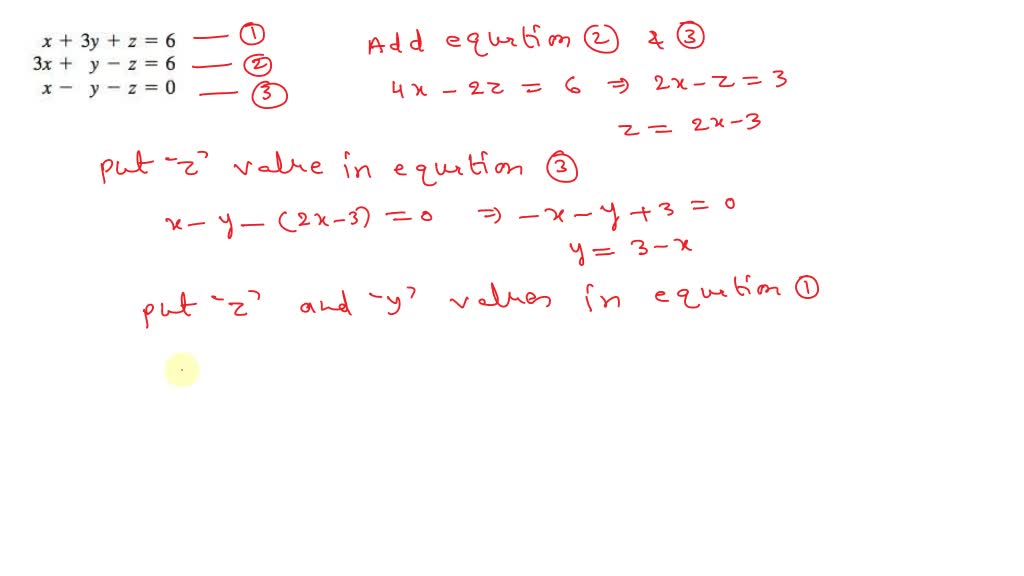



Solved Solve The Following X 2 Y 2 Z 2 Xy Xz Yz 6 0 Given That X Y And Z Do Not Equal 0



Find The Directional Derivative Of Xy 2 Yz 2 Zx 2 Along The Tangent To Curve X T Y T 2 Z T 2 At 1 1 1 Mathematics Is Life




Factorise X 2 Y 2 Z 2 Xy Yz Zx Youtube



What Is The Way To Factorize X 2 Y 2 Z 2 Xy Yz Zx Quora




If X Y Z 6 And Xy Yz Zx 11 And Xyz 6 Is Given Find The Value Of X 3 Y 3 Z 3 Youtube




Find The Product X Y Z X 2 Y 2 Z 2 Xy Yz Xz Youtube




X2 Y2 Z2 24 Nd Xy Yz Zx Find X Y Z Brainly In



Unomaha Edu




X 2 Y 2 Z 2 Greater Than Xy Yz Xz Proof Important For Iit Jee Nda Scra Sat Competitive Exams Youtube




If X Y Z 6 And Xy Yz Zx 11 And Xyz 6 Is Given Find The Value Of X 3 Y 3 Z 3 Youtube



Show That The Functions U X Y Z V Xy Yz Zx And W X 3 Y 3 Z 3 3xyz Are Independent And Find The Relation Between Them Mathematics
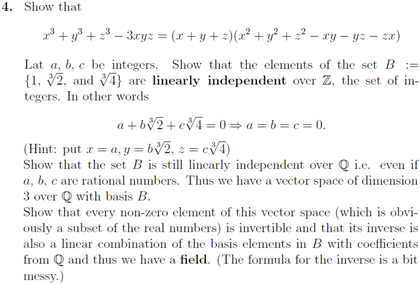



Show That X3 Y3 Z3 3xyz X Y Z X2 Y2 Chegg Com



If X Y Z 2 Xy Yz Zx 11 And Xyz 12 Then What Is The Value Of X 3 Y 3 2 Quora
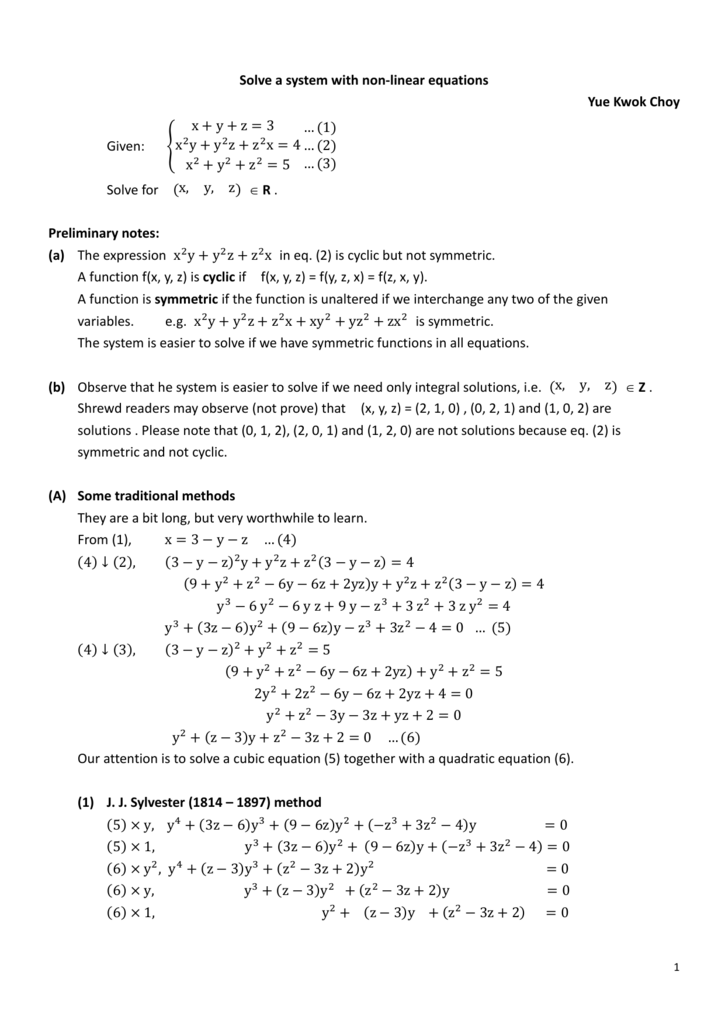



Solve A System Of Non Linear Equation Docx




If Delta 1 1 1 1 X 2 Y 2 Z 2 X Y Z And Delta 2 1 1 1 Yz Zx Xy X Y Z Then Without Expanding Show That Delta 1 Delta 2




Prove That Yz X 2 Zx Y 2 Xy Z 2 Zx Y 2 Xy Z 2 Yz X 2 Xy Z 2 Yz X 2 Zx Y 2 Is Divisible By X Y Z And Hence Find The Quotient
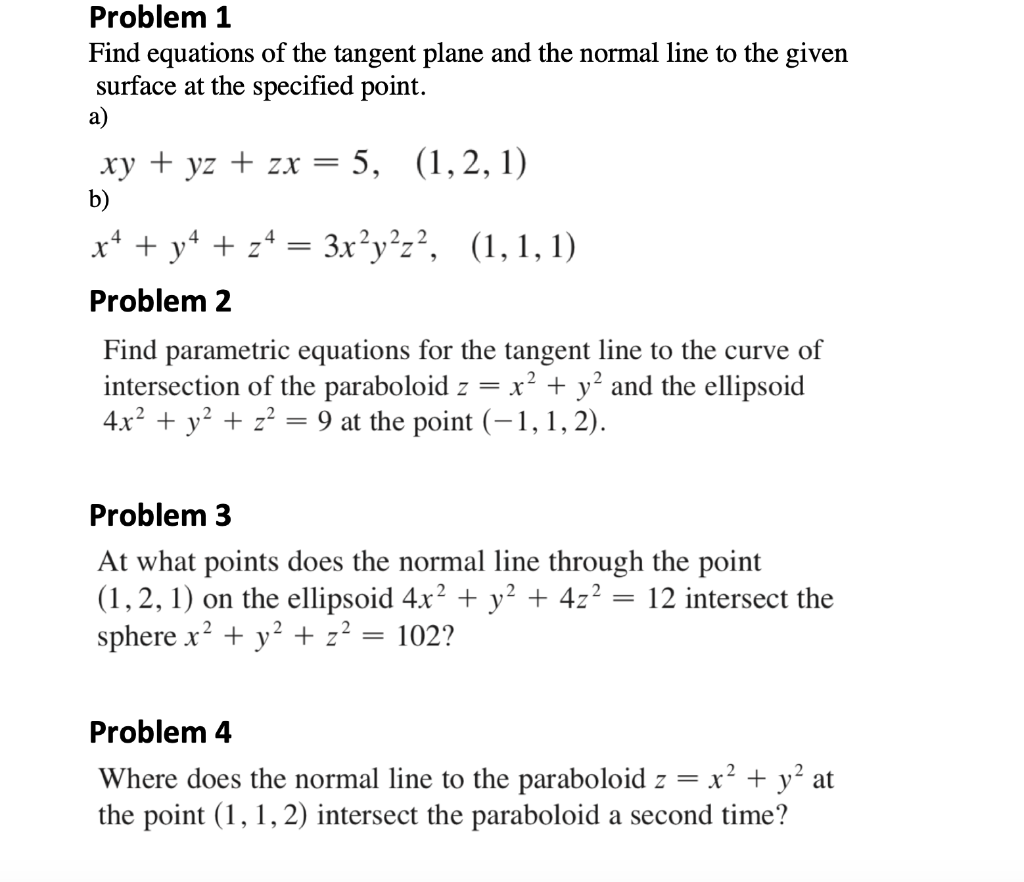



Solved Problem 1 Find Equations Of The Tangent Plane And The Chegg Com
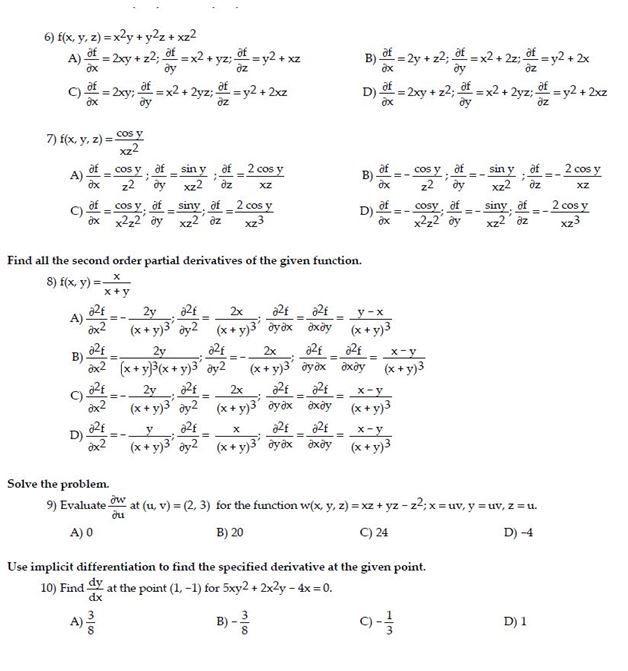



Solved F X Y Z X 2y Y 2z Xz 2 Partial Differential Chegg Com



Ualberta Ca




X 2 Y 2 Z 2 100 Xy Yz Zx 2 Brainly In



Solved Find The Integral Surface Of The Partial Differential Equation 2xy 1 P Z 2x3 Q 2 X Yz Through Curves X 1 And Y 0 Course Hero
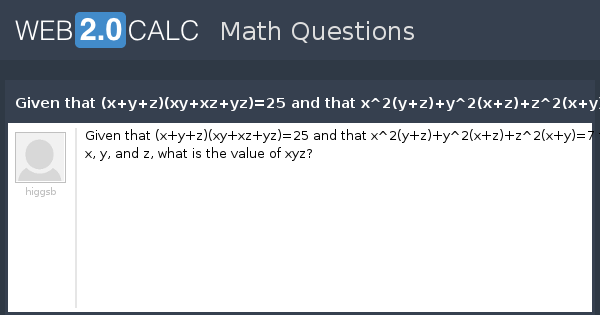



View Question Given That X Y Z Xy Xz Yz 25 And That X 2 Y Z Y 2 X Z Z 2 X Y 7 For Real Numbers X Y And Z What Is The Value Of Xyz




Se Cse Pde Pages 1 17 Flip Pdf Download Fliphtml5
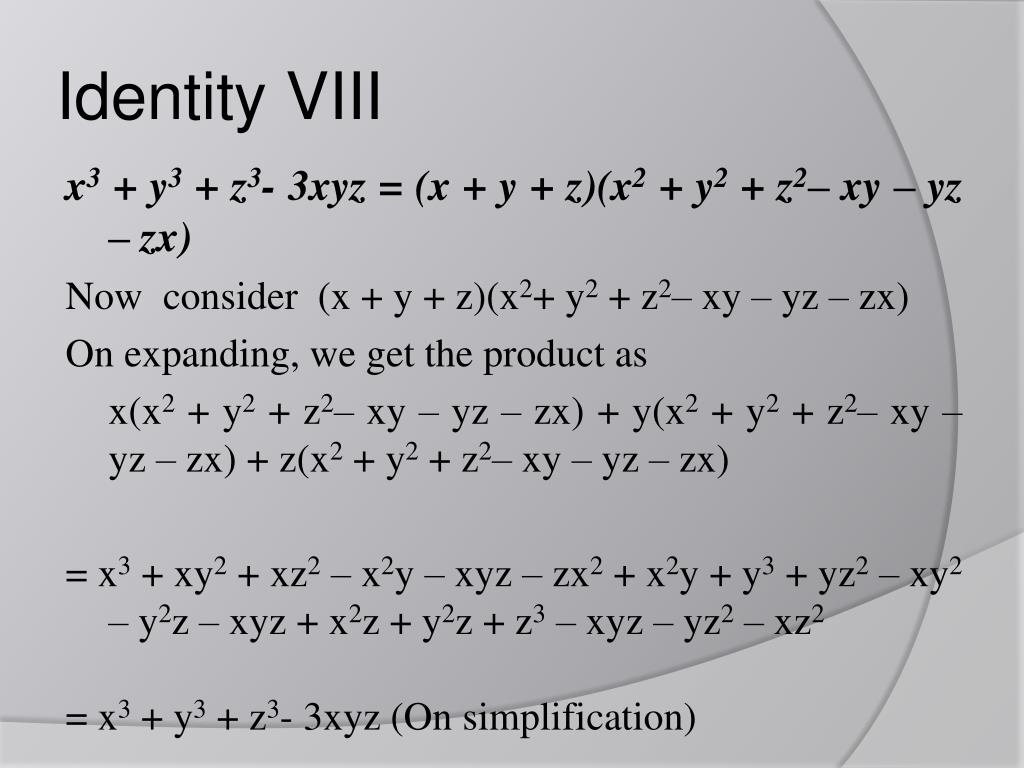



Ppt Polynomials Powerpoint Presentation Free Download Id




Find The Product X Y Z X 2 Y 2 Z 2 Xy Yz Zx




If X Y Z 9 And X Y Y Z X Z 26 Find The Value Of X2 Y2 Z2 Brainly In




X Y Z Belong To R X Y Z 4 X 2 Y 2 Z 2 6 Find Maximum Possible Value Of Z Mathematics Topperlearning Com 2j1z7sww



If X Y And Z Are Real Numbers Such That X Y Z 1 Then What Is The Value Of Xy Yz Xz Quora
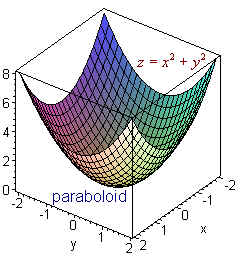



Surfaces



Solved Solve Yz 2 X 2 Yz Dx Zx 2 Y 2 Xz Dy Xy 2 Z 2 Xy Dz 0 Subject Differential Equation And Integral Equation Course Hero



What Are X Y And Z If X 2 Xy Y 2 7 Y 2 Yz Z 2 13 And Z 2 Xz X 2 19 Quora



Solved Solve Yz 2 X 2 Yz Dx Zx 2 Y 2 Xz Dy Xy 2 Z 2 Xy Dz 0 Subject Differential Equation And Integral Equation Course Hero
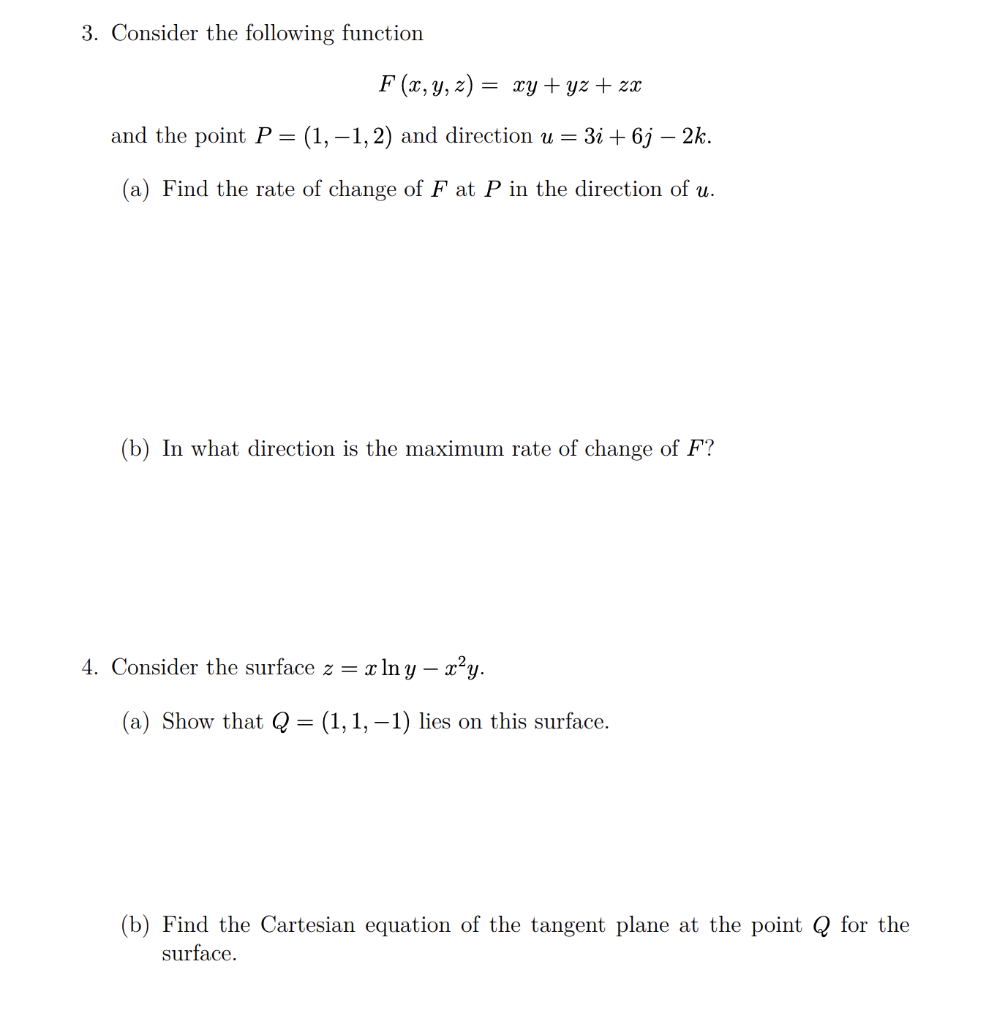



Solved 3 Consider The Following Function F X Y Z Xy Chegg Com



Find The Directional Derivative Of F X 2yz 4xz Xyz At 1 2 3 In The Direction Of Vector 2i J K Sarthaks Econnect Largest Online Education Community
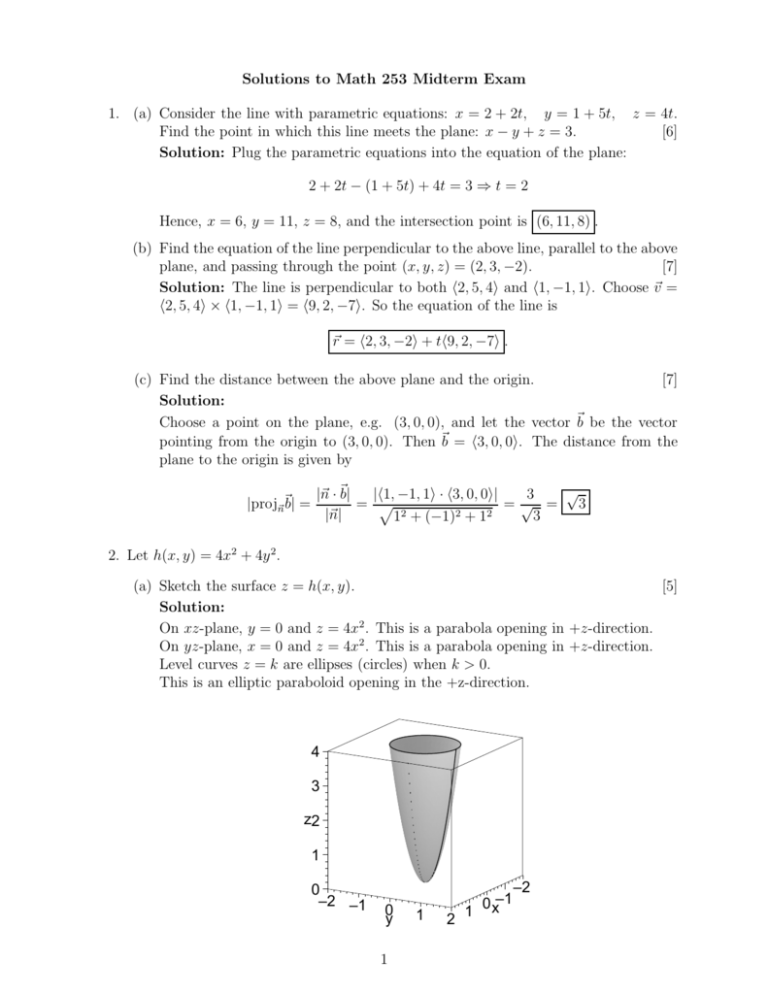



2 101 2 X 2 10 1 Y 0 1 2 3 4 Z




X 3 Y 3 Z 3 3xyz X Y Z X 2 Y 2 Z 2 Xy Yz Zx A 3 B 3 C 3 3abc A B C A 2 B 2 C 2 Ab Ca Youtube



If X Y Z 1 X 2 Y 2 Z 2 Xy Yz Zx 18 What Is Value Of X Y Z Quora




If X2 Y2 Z2 Xy Yz Xx O Prove That X Y Z Maths Polynomials Meritnation Com




Factorise X 2 Y 2 Z 2 Xy Yz Zx




Tangent Plane To X 2 Xy Y 2 Z 0 Youtube
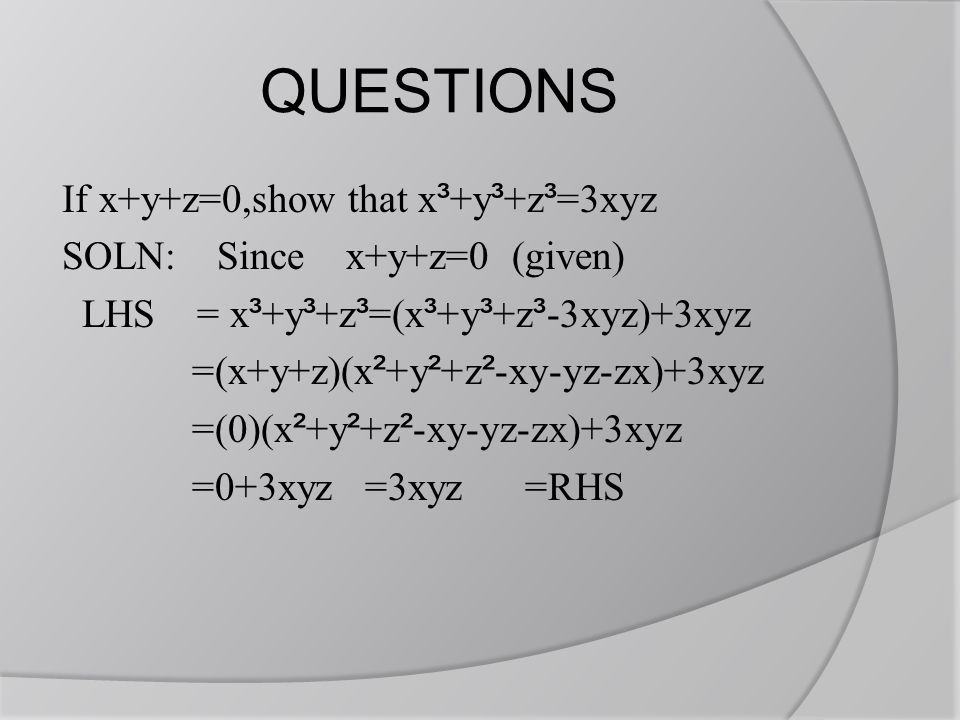



Polynomials Ppt Video Online Download




How To Solve Cyclic Differential Equations



1




Pdf Extrema Of Xy Yz Zx When X Y Z And Xyz Are Constant




Show That Yz X 2 Zx Y 2 Xy Y 2 Zx Y 2 Xy Z 2 Yz X 2 Xy Z 2 Yz X 2 Zx Y 2 R 2 U 2 U 2 U 2 R 2 U 2 U 2 U 2 R 2 Where R 2 X 2 Y 2 Z 2 And U 2 Xy Yz Zx



Let Math X 2 Y Z Y 2 Z X Z 2 X Y Math What Is The Value Of Math Frac 1 1 X Frac 1 1 Y Frac 1 1 Z Math Quora




Show That The Equation X 2 Y 2 Z 2 X Y Y Z Z X Has Infinitely Many Solutions In Integers X Y Z M Cube Mathematics By Maheshwari




Jacobian If U Xyz V X 2 Y 2 Z 2 W X Y Z Find J X Y Z U V W Youtube



X3 Y3 Z3 3xyz




Factorising Cyclic Expression X 2 Y Z Y 2 Z X Z 2 X Y Youtube




A Rigid Body Rotates About An Axis Through The Origin With An Angular Velocity 10v3 Radians Sec If W Points In The Direction Of I Then The Equation To The Locus Of The




If X 2 Y 2 Z 2 1 Then Xy Yz Zx Lies In
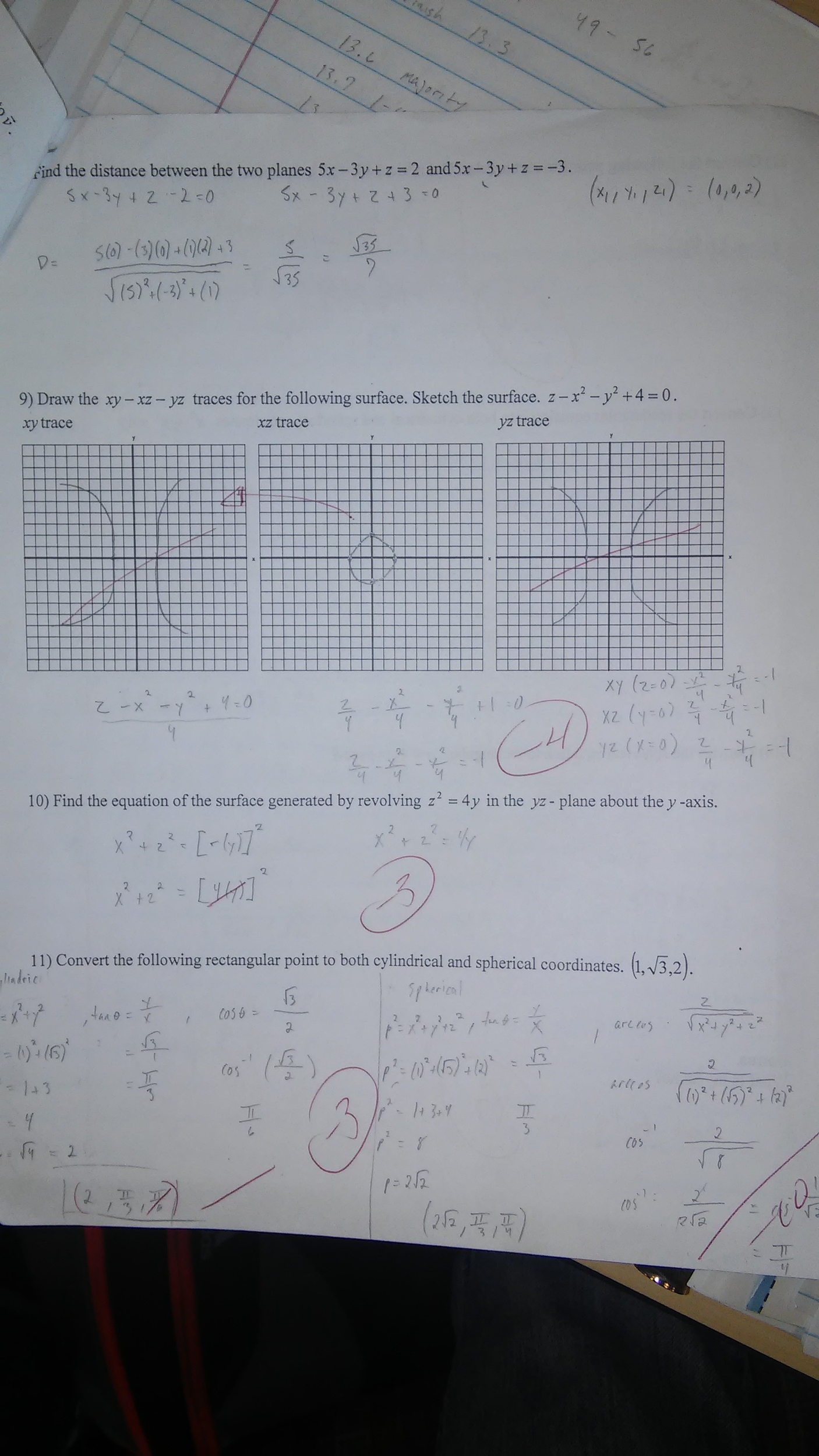



Solved 9 Draw The Xy Xz Yz Traces For The Following Chegg Com




Factorize 1 X Y Z Xy Yz Zx Xyz Youtube
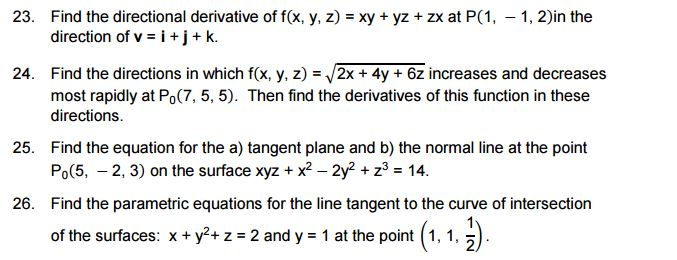



Solved 23 Find The Directional Derivative Of F X Y Z Chegg Com




Http Www Aplustopper Com Solving A Quadratic Equation By Factoring Maths Solutions Quadratics Quadratic Equation




Consider Z Sqrt X 2 Y 2 Give The Domain And Range Draw The Zx And Zy Traces In Two Homeworklib




X3 Y3 Z3 3xyz X Y Z X2 Y2 Z2 Xy Yz Zx Proof It Lhs To Rhs Brainly In




X Y Z X2 Y2 Z2 Xy Yz Zx Is This Any Formula Brainly In
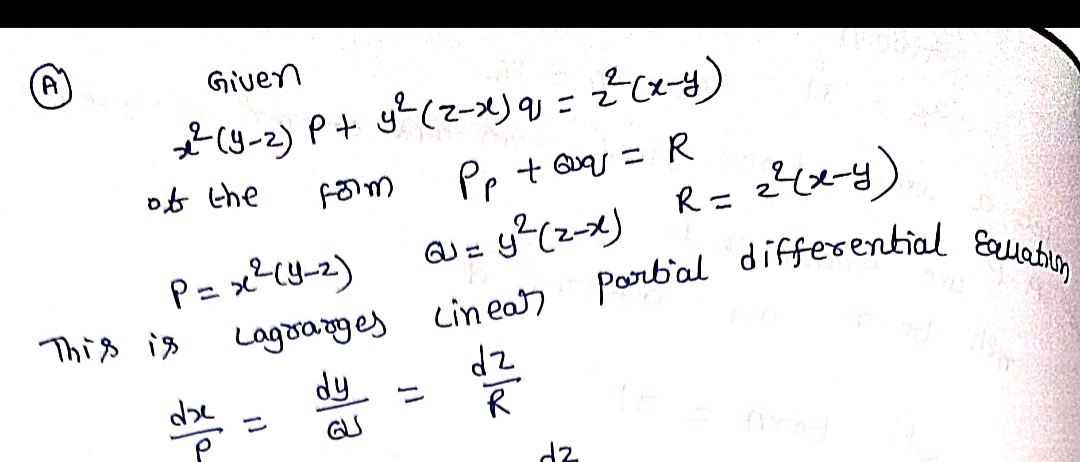



Answered Solve X2 Y Z P Y2 Z X Q Z2 X Y Bartleby




How To Factorise Using The Identity X3 Y3 Z3 3xyz X Y Z X2 Y2 Z2 Xy Yz Zx Youtube



Solved Solve Yz 2 X 2 Yz Dx Zx 2 Y 2 Xz Dy Xy 2 Z 2 Xy Dz 0 Subject Differential Equation And Integral Equation Course Hero
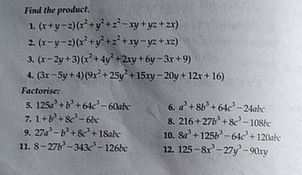



Find The Product 1 X Y Z X2 Y2 Z2 Xy Yz Zx 4 Gr Scholr




Mathematics Class 9th Chapter 4 Solution




Surfaces Part 2



How To Show That The Cone Yz Zx Xy 0 Cuts The Sphere X2 Y2 Z2 A In Two Equal Circles And What Is Their Area Quora




If Xy Yz Zx 1 Prove That X 1 X 2 Y 1 Y 2 Z 1 Z 2 4 Xyz 1 X 2 1 Y 2 1 Youtube




Solved 31 36 Find Equations Of A The Tangent Plane And B Chegg Com



0 件のコメント:
コメントを投稿